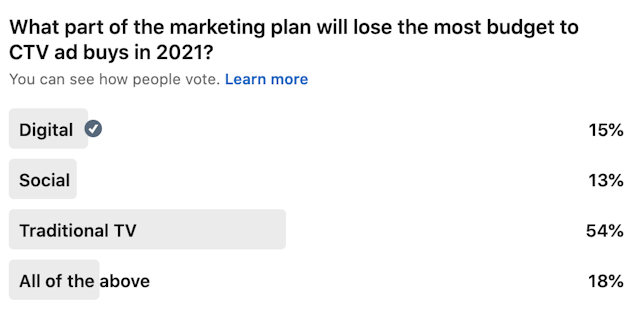If 2020 was the year of CTV, 2021 will be the year of CTV advertising
After connected TV's breakthrough 2020, The Drum columnist and head of strategic partnerships at Publica, Paul Gubbins, explores how the CTV advertising market is likely to mature in 2021.

If 2020 was the year of CTV, 2021 will be the year of CTV advertising
This is where I would ordinarily insert lots of charts about the growth of CTV but it should now be pretty obvious to everybody that has a TV at home how 2021 will shape up when it comes to the future of TV advertising.
If your viewing habits have been like mine in lockdown, you too will be watching a lot of streaming content via SVOD services but quickly increasing the content you stream via free ad supported apps more commonly referred to as AVOD. This is a trend playing out in the US also as illustrated in a recent Unruly CTV report that found 73% of US consumers would rather watch their favorite TV show for free with ads.
So let’s take a look at how the streaming market will continue to evolve and mature next year.
The CTV supply side
The CTV publisher ecosystem is no different from the display or mobile publisher ecosystem. Some publishers are really advanced in their monetization journeys while others are still very much in test and learn mode.
Although those in the display programmatic ecosystem are no longer wowed by the theory of header bidding as it is now well and truly established as a proven way to increase publisher yields, the practice of running a unified auction is still new to many CTV publishers who are in the process of building out their monetization strategies and thus far, have either been dependent on their direct sales team plus a waterfall of SSP partners or just picking an exclusive SSP to resell for them.
Some predictions
CTV publishers quickly realise like display publishers did that programmatic is not just for unsold, but it is increasingly being used to transact tier 1 inventory deals and to restrict OpenRTB demand from accessing your P1/2 inventory will hinder your ability to capture agency demand in 2021 as more buyers opt to transact OTT inventory via PMPs & programmatic guaranteed bookings rather than IO’s.
The majority, if not all, tier 1 CTV publishers transition from SSP waterfalls and exclusive reseller agreements to adopt a demand agnostic header bidding approach that lets all programmatic demand compete equally for their streaming inventory. Those that have direct sales teams will also start to let programmatic demand compete equally with their direct sold deals.
1st party data, show level insights and context will all feature heavily in CTV PMPs next year and companies already helping streaming publishers to activate these strategies include the likes of LiveRamp, Peer 39 and IRIS.TV. A lot of the data signals buyers take for granted in display buying today are yet to enter the CTV ecosystem, however, the tools now exist for publishers to surface these parameters to those on the buy side and streaming publishers will see a big increase in advertising revenues as a result of these additional insights they can now activate.
As more money flows into the addressable TV ecosystem in 2021, so will the practice of fraud from bad actors and this is why we will see more CTV publishers opting to support initiatives from the IAB Tech Lab such as app-ads.txt to ensure they doing all they can to mitigate against domain spoofing and unauthorized reselling of their valuable streaming inventory.
CTV publishers will offer buyers more controls (competitive ad separation, ad deduplication etc) within their ad breaks. Thus far, the controls available to advertisers in traditional TV ad buys have been somewhat absent from streaming publishers but tech companies such as Publica and others are now enabling OTT publishers to construct AdPods that look and feel like linear ad breaks with a seamless flow of content and ads that improves both advertiser ROI and viewer experiences.
The CTV buy side
As audiences have cut the cord on their cable subscriptions and headed towards OTT services, advertisers have been quick to follow them. By the end of next year, the majority of all digital advertising will be transacted via programmatic executions and the DSPs that facilitate these buys have quickly built features to support the CTV ecosystem. If in any doubt, just look at the recent TTD earnings reports to see how their CTV numbers are growing.
Smart buyers are quickly realising that they can for the first time activate their digital insights housed in DMPs and CDPs across the premium and lean forward environments of television via CTV buys and this is going to enable streaming publishers to grow their advertising revenues next year not just from traditional TV ad budgets, but also digital display and social buyers who have thus far been locked out of broadcast ad buys due to either cost or a lack of data to target.
So with each 2021 forecast predicting major ad revenue growth for CTV publishers next year, where will these budgets come from?
I posted a poll on Linkedin to try and better understand this question myself, the poll has been live for less than 24 hours at the time of writing and has already had over 150 votes from a cross section of the industry ranging from agency CEOs right through to FMCG brand marketing leads. As you can see, there is a real perception that growth in CTV ad spend will come from traditional TV budgets next year while social and digital display budgets will be eroded by CTV also:

Some predictions:
Buyers will increase their investments in CTV PMPs as publishers start to surface more 1st party data within the ad slots DSPs can target in OTT AdPods. Buyers will also start to proactively target the CTV publishers that have configured their ad breaks to offer the same controls that are available to them in traditional TV ad buys such as competitive ad separation features. This will result in lost budget opportunities for those streaming publishers who have not yet configured intelligent ad break experiences for buyers.
As AVOD inventory liquidity grows driven by consumer adoption, as will the practice of supply path optimisation, more commonly referred to as SPO. As we have established, more publishers will be adopting CTV header bidding next year as it enables them to grow their advertising budgets, however, DSPs will start to see the same inventory from each of the SSPs they are connected to just like they did post the adoption of display header bidding (remember all of the sell side feature releases and M&A around bid throttling/shaping to ease bidder QPS strains?) and this will accelerate the practice of CTV SPO next year as buyers try to establish the most direct, efficient & transparent route to supply.
Advertisers who are struggling to navigate the display ID headwinds that 2021 will bring will increasingly turn to the App based CTV ecosystem that is free from 3rd party cookie dependency due to the their ability to continue to manage controls around reach, frequency and attribution in ways that will become increasingly difficult to them via their display buys. CTV publishers are uniquely placed to extract consent & buyers will find the audience rich, privacy compliant supply ecosystem of CTV underpinned with a deterministic ID a valuable environment to increase their data driven ad buys within. CTV Apps operate independently of the changes happening in the mobile App ecosystem remember.
Buyers will push governing bodies such as the IAB to build more CTV protocols, they know their audiences are there, however, the programmatic infrastructure that is and will support their increased demand in 2021 needs to be ready to support the full technical nuances of CTV/OTT and not just mobile, display & video.
Conclusion
2020 was a transformational year for CTV, the global lockdown accelerated a shift in consumer behaviour that was already well underway, there is no going back!
2021 will see smart TV manufacturers making OTT Apps more discoverable via improved search features, AVOD Apps building the ad break infrastructure needed to capture traditional TV ad budgets and buyers, will increase their ad budgets in streaming environments due to an increased confidence around AdPod controls, brand safety, data, privacy compliance, identity & the most crucial component, reaching audiences they will increasingly struggle to target via traditional TV ad buys.
If 2020 was the year of CTV, 2021 will be the year of CTV advertising!

